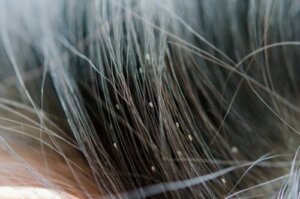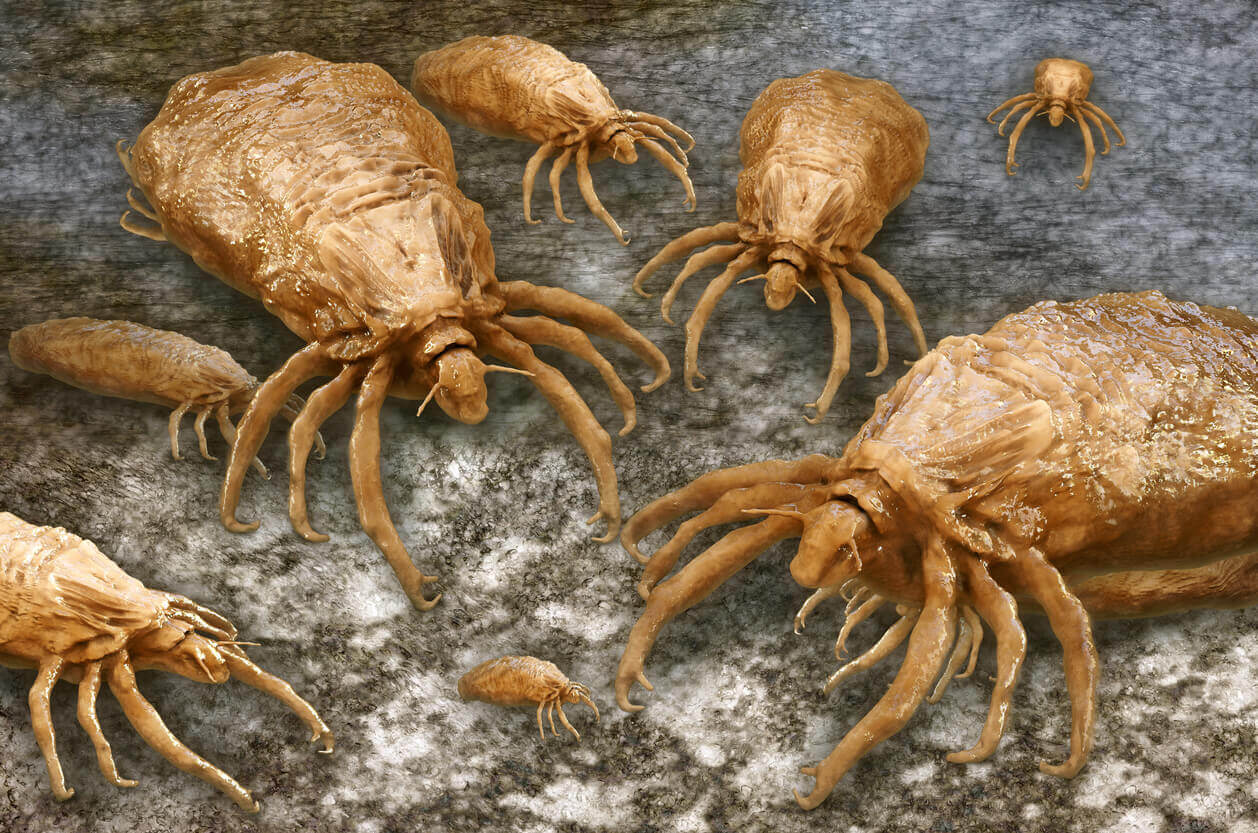Nits: What Are Lice Eggs Made Of?


Written and verified by the dermatologist Maria del Carmen Hernandez
Nits occur not only in children but also in adults. Even the location can vary according to the person’s age. In the following article, we want to talk specifically about lice eggs, or nits. Keep reading!
What are nits?
Nits are the eggs that adult lice lay at the roots of the hair, near the scalp. They’re often confused with dandruff, as they have a similar shape and color. However, they’re different entities.
It’s believed that an adult louse lays about 10 eggs per day, and once they’ve been laid, it takes about 8 days for the nymphs to hatch.
This period may vary due to ambient temperature conditions or the density and humidity of the hair. In general, the areas where nits are most frequently located are the temples, the area behind the ears, and the nape of the neck.
Embryonic eggs are oval in shape and measure less than 1 mm in diameter, are gray and gelatinous in appearance, and are usually located very close to the scalp. On the contrary, those nits that are more than 1 cm from the hair root are empty and are not a sign of active infestation.
You may be interested in: Does Apple Cider Vinegar Work Against Lice?
Composition of lice eggs

Nits adhere to the base of the hairs thanks to the secretions of the accessory gland of the female louse. This is a glue-like substance that she deposits, which sets quickly as the egg is laid.
The glue immediately hardens into a sheath that covers and protects the nit, but leaves an open hole for the embryo to breathe called an operculum. The molecular composition of the sheath was previously believed to be resistant a chitin, but this theory has been disproven in more recent studies.
Also read: Pediculosis in Children: What You Need to Know About Lice
Nit treatments
Faced with a lice infestation, the first action to take is to eliminate nymphs and adult lice. Once completely eradicated, you need to proceed with the removal of the hatched and empty lice eggs.
Nit removal is hampered by their firm grip on the hair shaft. For this reason, it’s one of the most complicated steps in the treatment of pediculosis in children and adults.
There are several therapeutic options that can effectively kill lice eggs. These include some over-the-counter products, prescription drugs, and natural remedies. However, there are no natural products recommended by the Centers for Disease Control and Prevention (CDC) for the treatment of nits.
For example, homemade solutions with tea tree oil or vinegar haven’t shown an effective enough response to solve this problem.
Nit shells attached to hairs after successful treatment of the infestation are a cosmetic problem. To remove them, multiple products are marketed that claim to help dissolve glue, digest it with enzymes, or make them slide out of the hair.
The truth is that, at present, the effectiveness of any home remedy for the removal of nits and lice has yet to be proven.
The importance of lice eggs
Complete eradication of nits can only be achieved with the use of a comb of tight, fine, and closely spaced teeth, called a nit comb. The most recommended types are metal, as they catch lice better and their eggs and are easy to slide.
Detecting nits isn’t an easy task, so it requires a careful examination of the scalp region with sufficient light, while the metal comb is being used. It’s best to do it from the base of damp hair outwards and explore the hair strand by strand. Especially in the areas behind the ears, the nape, and under the bangs.
Nits can remain attached to hair for a long time if they’re not physically removed. According to the recommendations of the Centers for Disease Control and Prevention (CDC), you need to remove all the nits after pediculicide treatment to end the infestation.

Nits are more than an infection
While the prognosis for head lice and nits is good, it can lead to social distress, isolation, and shame in children.
Therefore, even if nits aren’t contagious, it’s best to try to remove them completely to avoid these distressing situations as they may limit little ones when it comes to being able to bond with others and may expose them to unfortunate comments.
Nits occur not only in children but also in adults. Even the location can vary according to the person’s age. In the following article, we want to talk specifically about lice eggs, or nits. Keep reading!
What are nits?
Nits are the eggs that adult lice lay at the roots of the hair, near the scalp. They’re often confused with dandruff, as they have a similar shape and color. However, they’re different entities.
It’s believed that an adult louse lays about 10 eggs per day, and once they’ve been laid, it takes about 8 days for the nymphs to hatch.
This period may vary due to ambient temperature conditions or the density and humidity of the hair. In general, the areas where nits are most frequently located are the temples, the area behind the ears, and the nape of the neck.
Embryonic eggs are oval in shape and measure less than 1 mm in diameter, are gray and gelatinous in appearance, and are usually located very close to the scalp. On the contrary, those nits that are more than 1 cm from the hair root are empty and are not a sign of active infestation.
You may be interested in: Does Apple Cider Vinegar Work Against Lice?
Composition of lice eggs

Nits adhere to the base of the hairs thanks to the secretions of the accessory gland of the female louse. This is a glue-like substance that she deposits, which sets quickly as the egg is laid.
The glue immediately hardens into a sheath that covers and protects the nit, but leaves an open hole for the embryo to breathe called an operculum. The molecular composition of the sheath was previously believed to be resistant a chitin, but this theory has been disproven in more recent studies.
Also read: Pediculosis in Children: What You Need to Know About Lice
Nit treatments
Faced with a lice infestation, the first action to take is to eliminate nymphs and adult lice. Once completely eradicated, you need to proceed with the removal of the hatched and empty lice eggs.
Nit removal is hampered by their firm grip on the hair shaft. For this reason, it’s one of the most complicated steps in the treatment of pediculosis in children and adults.
There are several therapeutic options that can effectively kill lice eggs. These include some over-the-counter products, prescription drugs, and natural remedies. However, there are no natural products recommended by the Centers for Disease Control and Prevention (CDC) for the treatment of nits.
For example, homemade solutions with tea tree oil or vinegar haven’t shown an effective enough response to solve this problem.
Nit shells attached to hairs after successful treatment of the infestation are a cosmetic problem. To remove them, multiple products are marketed that claim to help dissolve glue, digest it with enzymes, or make them slide out of the hair.
The truth is that, at present, the effectiveness of any home remedy for the removal of nits and lice has yet to be proven.
The importance of lice eggs
Complete eradication of nits can only be achieved with the use of a comb of tight, fine, and closely spaced teeth, called a nit comb. The most recommended types are metal, as they catch lice better and their eggs and are easy to slide.
Detecting nits isn’t an easy task, so it requires a careful examination of the scalp region with sufficient light, while the metal comb is being used. It’s best to do it from the base of damp hair outwards and explore the hair strand by strand. Especially in the areas behind the ears, the nape, and under the bangs.
Nits can remain attached to hair for a long time if they’re not physically removed. According to the recommendations of the Centers for Disease Control and Prevention (CDC), you need to remove all the nits after pediculicide treatment to end the infestation.

Nits are more than an infection
While the prognosis for head lice and nits is good, it can lead to social distress, isolation, and shame in children.
Therefore, even if nits aren’t contagious, it’s best to try to remove them completely to avoid these distressing situations as they may limit little ones when it comes to being able to bond with others and may expose them to unfortunate comments.
All cited sources were thoroughly reviewed by our team to ensure their quality, reliability, currency, and validity. The bibliography of this article was considered reliable and of academic or scientific accuracy.
- Burgess IF. How long do louse eggs take to hatch? A possible answer to an age-old riddle. Med Vet Entomol. 2014 Jun;28(2):119-24. doi: 10.1111/mve.12026. PMID: 24987776.
- Brunton ER, Whelan IP, French R, Burgess MN, Burgess IF. Head louse egg and nit remover-a modern “Quest for the Holy Grail”. PeerJ. 2019 Apr 15;7:e6759. doi: 10.7717/peerj.6759. PMID: 31024767; PMCID: PMC6472470.
- Preguntas frecuentes sobre el tratamiento de los piojos. [Internet] Disponible en: https://www.cdc.gov/parasites/lice/head/es/informativa/preguntas_tratamiento.html
- Meister L, Ochsendorf F. Head Lice. Dtsch Arztebl Int. 2016 Nov 11;113(45):763-772. doi: 10.3238/arztebl.2016.0763. PMID: 27974145; PMCID: PMC5165061.
This text is provided for informational purposes only and does not replace consultation with a professional. If in doubt, consult your specialist.








